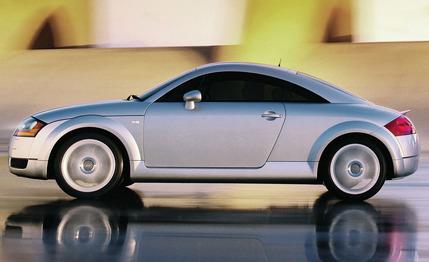 First Drive Review
First Drive Review
There appeared to be a problem for Audi and its hot TT, as evidenced by a troubling number of high-profile, high-speed crashes, most of them in Europe, where speed limits are more theoretical. As we reported last month, a recall was issued, and Audi sought to soften the car's handling by taking it closer to the character of a sedan, essentially widening the point where the driver begins to feel the car's significant limits.
The engineers continue to defend the car's original chassis settings, while quietly acknowledging that they recommended a rear spoiler to reduce lift at the rear axle, the prime source of the handling problems. Stylists resisted the spoiler.
"There was a lot of discussion during development, and we all decided not to include a spoiler," admits Dr. Bernd Heissing, Audi's head of chassis development. "Now, we've changed our minds."
As mentioned, the TT's flaw is primarily a Germany-only problem, because it's the only country in Europe where it's legal to exceed 80 mph. One TT driver was killed on a notorious high-speed autobahn curve. A second fatality occurred to an unbelted rear-seat passenger. Audi reports its accident investigation group has studied 22 totaled TTs. That may sound like a lot, but more than 40,000 TTs have been sold worldwide, and apparently the ratio of accidents is in line with that of other sports cars.
Audi says the main aim of the changes is to increase understeer, reduce lift-off oversteer, and improve high-speed stability. The TT coupe and roadster get modified front control arms with altered compliance in the mounting bushings. The front shocks are stiffer in compression and softer in rebound to reduce the pitch motion and weight transfer from rear to front when braking. The front anti-roll bar has been made one millimeter thicker, and the rear is 1mm smaller in diameter.
More obviously, all TTs get a small rear spoiler mounted to the decklid in a move aimed at reducing lift on the rear axle at high speeds. The TT has 148 pounds of lift at the rear axle at 125 mph without the spoiler, but only a 53-pound lift when the spoiler is fitted. By comparison, the BMW Z3 coupe generates 64 pounds of lift at 125 mph; the Mercedes-Benz SLK, 104 pounds of lift; and the Porsche Boxster, 68 pounds of lift. The chassis engineers claim they could have solved the problem without the spoiler, but this would have meant a significant increase in understeer at normal speeds, a trait they wanted to avoid. All TTs also get a version of VW's switchable Electronic Stability Program (ESP).
Driving TTs old and new at Goodyear's Luxembourg proving ground and on surrounding roads demonstrated the effectiveness of the changes, most obviously when you swap lanes and brake at speeds above 100 mph. No, not a condition you're often likely to encounter, but for the record, the spoiler does its job, the tail is no longer wayward, and stability is much improved. The TT now inspires far greater confidence in such circumstances.
At less exciting speeds, it's the steering that gives the modifications away. The suspension changes have the effect of slowing the steering, so turn-in is more gradual, and any given corner demands more lock.
It seems logical to expect that the Mercedes-Benz Vision SLR and the BMW Z8, two cleanly styled performance cars, will also need some kind of alteration to prevent the same lift-off and braking aero problems. The first preproduction Z8s are pure of shape, but spy photos show the car wearing a rear spoiler at testing at the Nürburgring, which suggests BMW plans a modification. And Mercedes insiders admit the Vision SLR concept car's underbody has already come in for revision to reduce aerodynamic lift at the rear.